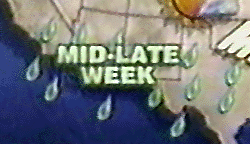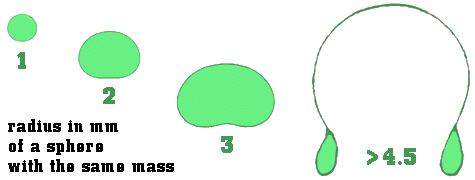because you will never, ever get it out.
Thomas Cardinal Wolsey (1471-1530)
 Bad Rain
Bad Rain
Click on the symbol for its explanation.
|
Be very, very careful what you put into that head, because you will never, ever get it out. Thomas Cardinal Wolsey (1471-1530) |
|
 Bad Rain Bad Rain
Click on the symbol for its explanation. |
 |
| Image derived from the Weather Channel |
The artistic representation of raindrop as presented by popular culture is that of a teardrop. Actually, real raindrops bear scant resemblance to this popular fantasy (except after they have ceased to be raindrops by splattering on a window, say). It may seem too easy a target to single out the Weather Channel for criticism for their shoddy representation when virtually everyone from advertisers to illustrators of children's books do likewise. Yet, I would like to think they could be held to a higher standard as they attempt to convey the image of purveyors of accurate information.
Small raindrops (radius < 1 mm) are spherical; larger ones assume a shape more like that of a hamburger bun. When they get larger than a radius of about 4.5 mm they rapidly become distorted into a shape rather like a parachute with a tube of water around the base --- and then they break up into smaller drops.
This remarkable evolution results from a tug-of-war between two forces: the surface tension of the water and the pressure of the air pushing up against the bottom of the drop as it falls. When the drop is small, surface tension wins and pulls the drop into a spherical shape. With increasing size, the fall velocity increases and the pressure on the bottom increases causing the raindrop to flatten and even develop a depression. Finally, when the radius exceeds about 4 mm or so, the depression grows almost explosively to form a bag with an annular ring of water and then it breaks up into smaller drops. See, for example Pruppacher and Klett, Microphysics of Clouds and Precipitation, (1978, Reidel, Boston), pp. 316-19, or any other book on cloud physics written by competent authors.
The way raindrops change in shape as they grow is sketched in the cross-sections of drops below. As the drops become distorted, the meaning of a radius becomes vague, so the radius labeled is that of sphere which has the same mass.
 |
| These are cross-sections through the drop. Imagine spinning the drop through a vertical axis to see the real shape. So, what looks like some teardrops in the final illustration on the right is actually closer to being a tube of liquid just before it breaks up into small spherical droplets again. |
Bad Rain FAQ
Before writing me with a question about this page, please check the Bad Rain FAQ to see if the issue has already been addressed satisfactorily.
